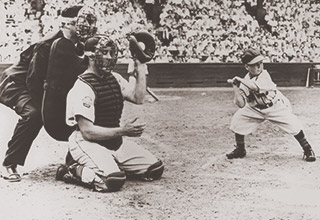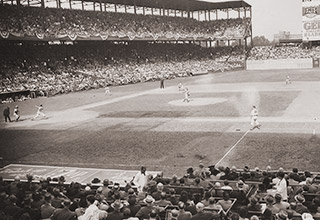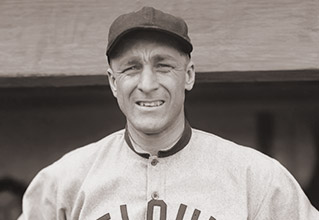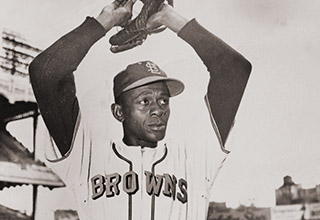Note
For a full experience, please visit this website on a desktop browser.
History
41 losing seasons in 52 years. A whiff of a World Series. Misfits, a midget, and money problems. The Browns are baseball’s losingest and least remembered team. But beneath the tarnish is true baseball gold. Heroes of the greatest generation. Moments of grit, guts and glory. A roller coaster of ruin and redemption. The Browns’ books have long been closed, but the legend of baseball’s most colorful underdogs deserves to endure forever. Please visit our site on a desktop or tablet for the full History experience.

The Early Years
In 1902, the Milwaukee Brewers moved to St. Louis with carriage-maker Robert Lee Hedges as the new owner. The club, a member of the American League, joined the National League’s Cardinals to become the town’s second (and soon favorite) baseball team. Hedges pinched several of the Redbirds’ notable players and rebuilt Sportsman’s Park, their former home. With this, the Browns’ legacy — and a hometown rivalry — began.
The Browns’ early years were rocky. They ended 1902 in second place with a 78-58 record. They lost nearly 100 games in 1905. In 1908, they climbed out of a slump to finish fourth in the league.
In 1915, manager Branch Rickey signed George Sisler to the Browns. Sisler would later become the only Hall of Famer in history to be inducted as a Browns player. In 1919, Browns owner Philip Ball committed an irreversible blunder — he fired Branch Rickey, who subsequently turned the Cardinals into one of baseball’s premier teams, and later made history by signing Jackie Robinson to the Brooklyn Dodgers.
In 1922, the Browns caught on fire. Outfielders Ken Williams, Baby Doll Jacobson and Jack Tobin all hit .300 or better, for the fourth season in a row. Williams became the founding member of the 30/30 Club — and the only member until 1956. George Sisler earned the league’s first-ever MVP award. And with their best-ever 93-61 record, the Browns finished the season 1 win short of tying the Yankees for the pennant.

The Bottom Dwellers
In the 1926 World Series, the Cardinals (now sharing Sportsman’s Park) beat the Yankees, and won back the hearts of local fans. The fanbase coup was just the beginning. After a string of years with 90+ losses, the Browns faced a catch-22: They needed good players to attract a crowd, but they needed a crowd to afford good players.
The Browns woefully attained their worst single-season attendance record in 1935. This record still stands as a major league low. Their all-time worst record (43-111) would come in 1939.

The War Years
When the U.S. entered World War II, President Roosevelt gave the “green light” to keep playing. New manager Luke Sewell got surgical with his 1942 roster, and rebuilt the team. The Browns lost a few men to the war effort, but other teams said goodbye to key players. By 1944, every Browns infielder was classified 4-F, or excused from military service, many for physical limitations. The Browns cashed in on their odds, opening the season with a bang — nine straight wins.
Cut to October 1, 1944, the last regular-season game. The pennant was at stake. No player on the Browns roster had ever made it to a World Series. The Browns led the visiting Yankees 5-2 into the ninth. Down to the final out, Oscar Grimes shot a high fly ball into foul territory. Browns first baseman George McQuinn nabbed it. Pandemonium ensued. The Browns were going to the World Series to face the Cardinals.
Thus began the Streetcar Series, called such because St. Louis had so many trolleys at the time. Both teams would have the home field advantage — the Cards for the first two and last two games; the Browns for the three in the middle. With a 3-1 Game 6 loss, the Browns said goodbye to their “Cinderella season” and World Series hopes. After World War II, the rest of the league’s talent was replenished. The Browns’ best years were put behind them as they returned to last place.

The Bill Veeck Era
Bill Veeck became the owner in 1951, bringing with him a radical approach to promotions — or, as he saw it, creative ways to attract a crowd and stir up drama with the Cardinals. Veeck brought three former Cardinals over to the Browns: Rogers Hornsby and Marty Marion as coaches, and Dizzy Dean as announcer. He also decorated Sportsman’s Park solely with Browns memorabilia.
For his first game as owner, Bill Veeck gave everyone in the ballpark a free beer or soda. On August 19, 1951, Veeck sent Eddie Gaedel up to pinch hit, standing 3-foot-7 with an impossible strike zone. Gaedel drew four straight balls in his only at-bat. His 1.000 career on base percentage remains in tact.
In 1953, August Busch, Jr., owner of Anheuser-Busch, bought the Birds. Veeck was no match for the financial, political and social power of the Busch family. Out of options, Veeck sold Sportsman’s Park to August Busch, Jr., for $800,000. Unable to relocate the Browns, Veeck sold the team to a Baltimore attorney and baseball-lover, Clarence Miles.
The Browns played their last game in St. Louis on September 27, 1953, against the White Sox in front of a crowd of 3,174. The White Sox won, 2-1.
In 1954, the Browns became the Baltimore Orioles.